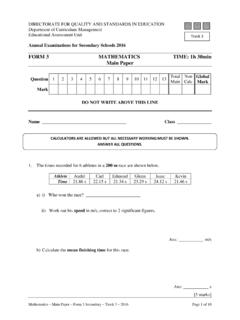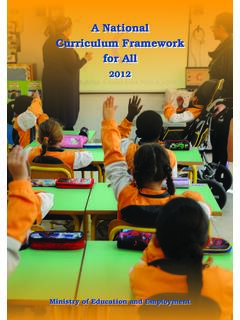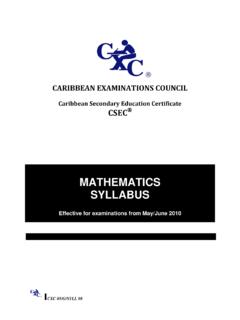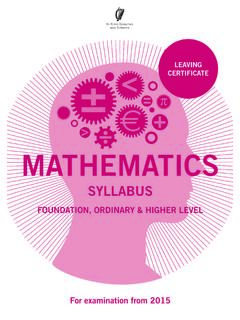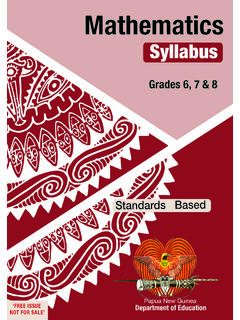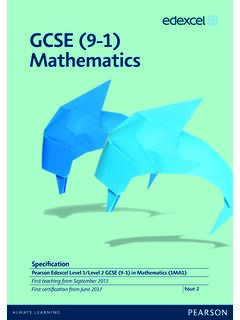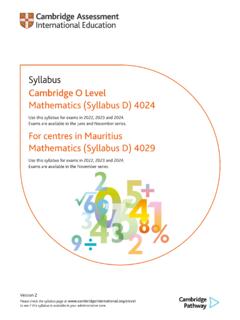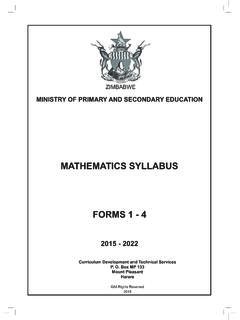Transcription of MATHEMATICS a revised Syllabus for Primary Schools
1 1 | P a g e D e p a r t m e n t o f C u r r i c u l u m M a n a g e m e n t - M a l t a MATHEMATICS a revised Syllabus for Primary Schools June 2014 2 | P a g e D e p a r t m e n t o f C u r r i c u l u m M a n a g e m e n t - M a l t a PREFACE The Primary MATHEMATICS Syllabus has been revised and will be put into effect as from the coming Scholastic Year (2014 2015).
2 The revised Syllabus is aligned with the rationale and aims of the National Curriculum Framework and is also addressing feedback received on the current Syllabus . Below are some changes that are prominent in the revised version: the Syllabus incorporates the rationale, the learning outcomes, a list of keywords (per topic per year) and various opportunities that the children should be given. A note about pre-numeracy skills is included. each topic is developed in detail from Year 1* to Year 6 on the same document. This decision has been taken to facilitate differentiation and progression. the list of opportunities per topic per year is long but not exhaustive.
3 It has been included to encourage application and reasoning: two important cognitive domains. The opportunities outlined are not mandatory but are to be treated as recommendations that enhance learning. Ultimately, it is the teacher to decide which opportunities best meet the needs of the students in the class. the learning outcomes have been kept to a minimum and are distributed almost equally across the years. the coding has also been revised to simplify its use. the revised Syllabus is emphasising that procedures (knowledge of rules and procedures used in carrying out routine mathematical tasks and the symbols used to represent MATHEMATICS ) should never be learned in the absence of a concept (logical relationships, representations, using manipulatives, an understanding and ability to talk, write and give examples of these relationships).
4 The Syllabus should guide the teaching and learning. The textbook is just one tool for the implementation of the Syllabus . Consequently, it is suggested that any guidelines by colleges/ Schools on the topics to be covered till the Half Year Exams (for Year 4 and Year 5 students) is to be informed by learning outcomes rather than by textbook pages. Feedback about the revised Syllabus is encouraged. The latter and/or any queries should be addressed to Melanie Casha Sammut, education Officer for Primary MATHEMATICS : . *Topic focusing on Multiplication and Division starts from Year 3. 3 | P a g e D e p a r t m e n t o f C u r r i c u l u m M a n a g e m e n t - M a l t a RATIONALE The ability to develop and apply mathematical thinking in order to solve a range of problems in everyday situations is important for all learners.
5 Through MATHEMATICS , learners acquire a sound knowledge of numbers, measures and structures, basic operations and basic mathematical presentations, an understanding of mathematical terms and concepts, and an awareness of the questions to which MATHEMATICS can offer answers. With increased fluency in MATHEMATICS , young people are provided with opportunities to deepen their mathematical knowledge and reasoning, to come more formally into contact with abstract and logical reasoning, and to better appreciate and apply the communication possibilities that the MATHEMATICS medium offers.
6 This Learning Area will include financial literacy aspects such as mathematical and financial understandings in order to ensure that a culture of financial planning and preparation is instilled and nurtured during the Junior and Secondary Cycles of education . (National Curriculum Framework, 2012, p. 35) 4 | P a g e D e p a r t m e n t o f C u r r i c u l u m M a n a g e m e n t - M a l t a The learning that takes place within the area of MATHEMATICS allows children to develop: Essential numeracy skills which support them in daily life.
7 Key numeric competences that include the understanding of concepts, principles, and applications. Creative approaches in the four strands, namely, use of number, measurement, space and shapes and data handling. Logical thought and engagement with investigative processes that lead to solutions. Application of mathematical concepts on matters relating to financial decisions and planning. All children need to experience MATHEMATICS as a rewarding and enjoyable experience. This can best be achieved by using a combination of different teaching styles and through differentiated teaching taking into consideration different learning styles.
8 (National Curriculum Framework, 2012, p. 53) 5 | P a g e D e p a r t m e n t o f C u r r i c u l u m M a n a g e m e n t - M a l t a During the MATHEMATICS lesson children should be given the possibility to experience various situations and opportunities as portrayed in Figure 1 below. Figure 1: Opportunities through the MATHEMATICS Lessons. Word cloud has been created using the online application Wordle. 6 | P a g e D e p a r t m e n t o f C u r r i c u l u m M a n a g e m e n t - M a l t a Achievement Aims of the MATHEMATICS Curriculum across the FOUR strands.
9 Number and Algebra The MATHEMATICS curriculum provides opportunities for children to: develop an understanding of numbers, the ways they are represented and the quantities for which they stand. develop accuracy, efficiency and confidence in calculating mentally, and on paper. develop an ability to estimate and to make approximations, and check the reasonableness of results and measurements. recognise patterns and relationships in MATHEMATICS and the real world. develop the ability to use symbols, notation, graphs and diagrams to represent and communicate mathematical relationships and concepts. Measurement The MATHEMATICS curriculum provides opportunities for children to: develop knowledge and understanding of systems of measurement and their use and interpretation.
10 Develop confidence and competence in using instruments and measuring devices. 7 | P a g e D e p a r t m e n t o f C u r r i c u l u m M a n a g e m e n t - M a l t a Space and Shapes The MATHEMATICS curriculum provides opportunities for children to: gain knowledge of geometrical relations in two and three dimensions and recognise and appreciate shapes in the environment. develop spatial awareness and the ability to recognise and make use of the geometrical properties and objects. develop the ability to use geometrical models as aids to solving practical problems in time and space.
